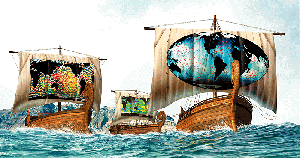Personnal view : from challenge to success
Michel Lefebvre, (JGOOS, France) TOPEX/POSEIDON project scientist, 1987-1995

The TOPEX/POSEIDON mission is widely considered a success.
To sum it up in a sentence: for the last four years we have been able to measure the ocean topography to within a centimetre, across a basin, on a one-month scale.
This accuracy, at global scale, provides the means for tackling new problems. Several hundred publications have appeared, based on analysis of the data and the first interpretations. The next step, as-similating the data into models, has begun.
Setting up the mission
Optimising the T/P mission design was the work of the Science Definition Team, a partnership between scientists and the project team, which continued to meet as a Science Working Team (SWT) throughout the different project phases.
This novel approach was our platform for success, the group members having worked on altimetry projects such as Skylab, Dorade, GEOS 3, SEASAT, NROSS, GEOSAT and ERS-1. Several had been involved in the major ocean observing pro-grammes Tropical Ocean and Global Atmosphere (TOGA) and World Ocean Circulation Experiment (WOCE).
All this experience was vital if we were to meet the ambitious, innovative goals set for T/P: the accuracy required would take us from simply detecting the signal to providing measurements useable as constraints for models.
We had to optimise all the sub-systems, obtain the best tradeoffs.
A good example is the satellite orbit. To determine solar tides while ob-serving all the oceans, we ruled out heliosynchronous orbits. The altitude also had to be as high as possible to avoid atmospheric drag effects, while maintaining a satisfactory link budget for the altimeter radar. And a 10-day repeat cycle was the best tradeoff for sampling the oceans. These choices meant T/P had to be placed on orbit from a powerful launch vehicle like Ariane 42P, from Kourou, French Guiana.
It is also not always easy to state a very precise specification. At the start of the design phase it was out of the question, technically, to consider an altimeter radar stable to within a millimetre. It would even have seemed a little weird when the uncertainty on some of the errors was still 10 cm! But the seed of the idea has now been sown, and the results show that a goal of a few millimetres is within reach and can become a specification.
Solving the problems together
The SWT includes project members and scientists. It has the skills needed to solve problems, and to define algorithms, hardware, data access, and so on. The science team of Primary and Co-Investigators (PIs and Co-Is) was selected through a joint NASA/CNES Announcement of Opportunity. The PIs quickly received the first data and the information needed to under-stand and use them. They were able to present their findings at the first verification workshop, six months after the satellite launch. Feedback has continued at the subsequent yearly SWT meetings.
From nominal requirements to ultimate accuracy
The sensitivity of each component in the altimeter system and of the altim-eter products, associated with the different types of residual errors, was analysed. As with any new system said to be more accurate, T/P data are difficult to assess: only a varied set of approaches - internal evaluations, external calibration, results from models - iteratively provide the accuracy. T/P accuracy which is 100 times higher than the previous experiments, and ten times higher than the expected results, could only be achieved by using all the available methods, approaches and components to determine the system accuracy.
Maximum benefit from system redundancies
We had to use all the redundancies. The two altimeters, three orbit track-ing systems, two ultra-stable oscillators and two calibration sites made cross-calibration and independent assessments possible. Several teams worked on each system component, and exchanged their findings.
A striking example is precise orbit determination, using three tracking systems. The first objective was to detect and measure the systematic error in each system: time synchronisation of 20 s for DORIS , radial range bias of 6 cm for GPS , and the transfer function for the array of laser corner cubes. Different methods were used to compute precise orbits: dynamic, reduced dynamic, quasi-geometric.
These enabled us to analyse the error sources from force models, station positions and signal propagation. The sensitivity of ocean surfaces to the remaining orbit errors, especially geographically correlated errors, was also carefully studied. Similar com-parisons were made for the iono-sphere, water vapour content, and EM bias, all to improve overall performance.
Dialogue between scientists and project teams allowed us to isolate the true geophysical and oceano-graphic signals. A wide variety of PI-driven comparisons with in situ data was also a crucial complement to the project teams' calibration sites.
Undreamt-of accuracy
At the end of the nominal mission in 1995, after the first three years of fruitful cooperation, the SWT agreed on the improvements to make, and the data were reprocessed.
This called for a lot of work from the processing and production centres, as well as extra expense, but it paid off.
We have achieved the most optimistic objectives. We can now envisage deriving sea level variations to within 2 mm a year.
Let's keep working
The T/P results achieved are encouraging for future accurate altimeter systems such as Jason.
They also confirm the need for permanent transatlantic dialogue among the technical staff and the user community, efficient interaction by operational teams, and quick, easy access to the data.
The way we are organised, including competition and emulation, seems about right. But it takes years to fully understand the processing, testing, evaluation and analysis of altimeter data, and we need to make the most of the investment. Keeping the teams going is as important as keeping the system going.





